Papers by Alessandra Giordano
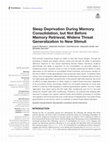
Frontiers in Neuroscience
Past aversive experiences shape our ability to deal with future dangers, through the encoding of ... more Past aversive experiences shape our ability to deal with future dangers, through the encoding of implicit and explicit memory traces and through the ability to generalize defensive reactions to new stimuli resembling learned threats. Numerous evidence demonstrate that sleep is important for the consolidation of memories related to threatening events. However, there is a lack of studies examining the effects of sleep deprivation on the retrieval of consolidated threat memories, and previous studies on the role of sleep in threat generalization have produced mixed results. To address these issues, here we adopted a differential threat conditioning and a delayed (second half of the night) sleep deprivation during the first or the seventh night after learning. We found no effects of sleep deprivation on either implicit or explicit threat memories, regardless of its occurrence timing. Conversely, implicit but not explicit responses to novel cues similar to a learned threat displayed a wi...
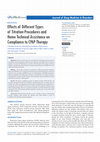
Objectives: The aim of the study was to clarify the relationships between titration procedures an... more Objectives: The aim of the study was to clarify the relationships between titration procedures and home technical assistance with compliance and adherence to continuous positive air pressure (CPAP) therapy in patients with obstructive sleep apnea syndrome (OSAS), evaluating the effectiveness of equation-based titrations and differences with standard titration procedures. Methods: The titration pressures as predicted by different equations (Stradling, Series and Hoffstein) were compared to the pressure assessed through auto-continuous positive airway procedure (APAP)(sub-study a) in 204 patients with OSAS. Secondary, efficacy, compliance and adherence to therapy, and satisfaction for technical assistance during the first 3 months of CPAP therapy were evaluated comparing different titration methods (sub-study b) in 289 patients. Results: We found a significant positive correlation between APAP titration and pressures predicted through three different equations(sub-study a), but(sub-study b) patients who underwent equation-based titration had significantly less satisfaction for the therapy, they used CPAP for less hours and showed more daytime somnolence than APAP titrated patients. Moreover a positive correlation was found between the overall satisfaction level with the home technical assistance and the hours of use of the CPAP per night in controls. Conclusion: Equation-based titrations, even if reliable at least in intermediate pressure regimens, seem actually less effective than APAP titration in terms of compliance and daytime residual sleepiness.
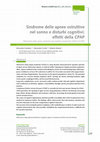
Reviews in Health Care, Sep 5, 2011
Obstructive Sleep Apnea Syndrome (OSAS) is a sleep disorder characterised by repetitive episodes ... more Obstructive Sleep Apnea Syndrome (OSAS) is a sleep disorder characterised by repetitive episodes of upper airway obstruction (apnea) or reduced airflow (hypopnoea) despite persistent respiratory effort. Apnea is defined as the cessation of breathing for at least 10 seconds during sleep, while hypopnoea is defined as at least 30% reduction in airflow for 10 seconds associated with oxygen desaturation and sleep fragmentation. The presence in the general population is about 4%. The principal symptoms are: excessive daytime sleepiness (EDS), snoring, dry throat, morning headache, night sweats, gastro-esophageal reflux, and increased blood pressure. Long term complications can be: increased cardio-cerebrovascular risk and cognitive impairment such as deficiency in attention, vigilance, visual abilities, thought, speech, perception and short term memory. Continuous Positive Airway Pressure (CPAP) is currently the best non-invasive therapy for OSAS. CPAP guarantees the opening of upper airways using pulmonary reflexive mechanisms increasing lung volume during exhalation and resistance reduction, decreasing electromyografical muscular activity around airways. The causes of cognitive impairments and their possible reversibility after CPAP treatment have been analysed in numerous studies. The findings, albeit controversial, show that memory, attention and executive functions are the most compromised cognitive functions. The necessity of increasing the patient compliance with ventilotherapy is evident, in order to prevent cognitive deterioration and, when possible, rehabilitate the compromised functions, a difficult task for executive functions.

Annals of Psychiatry and Treatment
Sleep medicine and psychology has a relatively long story to share. The multidisciplinary nature ... more Sleep medicine and psychology has a relatively long story to share. The multidisciplinary nature of sleep medicine requires that different specialists work together to diagnose and treat sleep disorders and improve subspecialty areas. In the last decades, various non-pharmacological therapies have been developed and demonstrated their efficacy. There are many non-pharmacological therapeutic available options for sleep disorders, including cognitive, behavioral, psycho-educational, and psychosocial interventions that could help clinicians to improve the quality of life of adult patients. Obstructive sleep apnea syndrome, insomnias, hypersomnias, circadian rhythm disorders, restless leg syndrome and parasomnias can be effectively taken care of, by an integrated approach with the support of sleep medicine psychologists. The paper aims to give a comprehensive view of psychological interventions for adults, in behavioral sleep medicine.

Archives of General Psychiatry, 1991
ABSTRACT Sixty-five patients with social phobia were treated in a study that compared a cognitive... more ABSTRACT Sixty-five patients with social phobia were treated in a study that compared a cognitive-behavioral group treatment program with pharmacotherapy with alprazolam, phenelzine sulfate, or pill-placebo plus instructions for self-directed exposure to phobic stimuli. Statistically significant repeated-measures effects were shown on all measures, indicating that the treatments studied were associated with substantial improvements in patients with severe and chronic social phobia. Patients who were treated with phenelzine were rated by clinicians as more improved on a measure of work and social disability than patients who were treated with alprazolam or placebo (patients in the cognitive-behavior therapy group were not rated on this measure). Subjects showed positive cognitive changes from before to after treatment, and there were no differences between treatment groups on the cognitive measure. We discuss the implications of these findings within the context of demographic and clinical predictors of response.
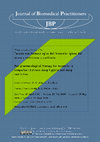
Introduzione L'insonnia è il più comune di tutti i disturbi del sonno interessando nel corso ... more Introduzione L'insonnia è il più comune di tutti i disturbi del sonno interessando nel corso della vita più del 40% della popolazione. La prima scelta terapeutica è di tipo non farmacologico ed è costituita dalla terapia cognitivo-comportamentale (TCC). Negli anni, è stata studiata l'efficacia della restrizione del sonno e delle regole di igiene del sonno, considerate sia singolarmente sia come parte di un programma più completo. Obiettivo Valutare e comparare l'efficacia delle tecniche di restrizione del sonno e igiene del sonno nel trattamento dell'insonnia cronica anche in relazione alla qualità di vita. Materiali e metodi L'efficacia terapeutica è stata valutata mediante actigrafia e diario del sonno, la qualità della vita è stata auto-valutata mediante somministrazione del questionario Short Form Health Survey (SF-36). Risultati Venti soggetti hanno completato lo studio. Nel gruppo restrizione di sonno, sono state evidenziate differenze statisticamente signi...
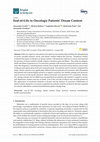
Brain Sciences, 2020
Both non-rapid eye movements and rapid eye movements sleep facilitate the strengthening of newly ... more Both non-rapid eye movements and rapid eye movements sleep facilitate the strengthening of newly encoded memory traces, and dream content reflects this process. Numerous studies evaluated the impact of diseases on dream content, with particular reference to cancer, and reported the presence of issues related to death, negative emotions, pain and illness. This study investigates death and illness experiences in 13 consecutive patients with sarcoma compared to paired controls, early after diagnosis, evaluating dream contents, fear of death, mood and anxiety, distress, and severity of disease perception (perceived and communicated). Ten patients and 10 controls completed the study. Dream contents were significantly different between patients and normative data (DreamSat) and patients and controls (higher presence of negative emotions, low familiar settings and characters and no success involving the dreamer). Illness and death were present in 57% of patients’ dreams (0% among controls)...
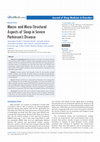
Objectives and background: Sleep disorders are common in Parkinson's Disease (PD) occurring in 60... more Objectives and background: Sleep disorders are common in Parkinson's Disease (PD) occurring in 60% to 98% of patients. Polysomnographic measures showed that patients with PD had significantly less total sleep time (TST), less sleep period time, increased number of awakenings and wake time after sleep onset (WASO) and, consequently, reduced sleep efficiency. The aim of the study was to explore the sleep pattern of PD patients, focusing on sleep microstructure by analysing the cyclic alternating pattern (CAP). Methods: Fourteen patients with idiopathic severe PD and fourteen matched healthy volunteers were recruited. All subjects underwent overnight polysomnography and completed Epworth Sleepiness Scale. Macro-and micro-structural sleep variables were evaluated. Results: Patients with PD had a reduced SE and increased rates of stage shifts and awakenings; the N2 and REM sleep percentages were lower and WASO was higher in patients. Moreover, patients with PD had lower total CAP rate and lower CAP rate in all NREM sleep stages (particularly in N3) than did normal controls. Moreover, the analysis of CAP A subtypes distribution showed a decreased A1 percentage in patients (more pronounced in N3) and a slight, not significant increase of A3 subtypes. Conclusions: The total CAP rate is reduced in these patients across all sleep stages and this reduction is mainly due to a decrease in CAP A1 subtype. The changes in the micro-and macro-structure of sleep could be only partially explained by the chronic partial sleep deprivation in PD patients.
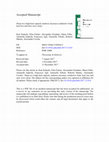
Physiology & Behavior, 2018
Environmental temperature can strongly affect sleep. The habitual sleep phase is usually located ... more Environmental temperature can strongly affect sleep. The habitual sleep phase is usually located between evening decline and morning rise of the circadian rhythm of core body temperature (CBT). However, the thermophysiological mechanisms promoting or disturbing sleep are not yet fully understood. The purpose of this study was to examine the effects of a high heat capacity mattress (HHCM) on CBT, skin temperatures and sleep in comparison to a conventional low heat capacity mattress (LHCM). Based on the higher heat capacity of HHCM an increase in conductive body heat loss enhances the nocturnal decline in CBT can be expected. Based on previous findings this may then be accompanied by an increase in slow wave sleep (SWS). The mattresses were studied in a randomized single-blind crossover design in fifteen healthy young men (Age: 26.9±2.1yr, BMI: 22.2±0.4kg/m 2) by overnight in laboratory standard videopolysomnography in a temperature stabilized setting. CBT, room temperature, and skin and mattress surface temperatures were continuously recorded in order to get information about inner and outer body heat flow. Additionally, subjective sleep quality was estimated by visual analogue scale. In comparison to LHCM sleep on HHCM exhibited a selective increase in SWS (16%, p<0.05), increased subjective sleep quality and sleep stability [reduced cyclic alternating pattern (CAP) rate; 5.3%, p<0.01]. Additionally, analyses of the sleep stages showed in the second part of the night a significant increase in SWS and a decrease in REMS. In addition, HHCM induced a greater reduction in CBT (maximally by-0.28°C), reduced the increase in proximal skin temperatures on the back (PROBA; maximally by-0.98°C), and delayed the increase in mattress surface temperature (maximal difference LHCM-HHCM: 6.12°C). Thus, the CBT reduction can be explained by an increase in conductive heat loss to the mattress via proximal back skin regions. Regression analysis identified PROBA as the critical variable to predict inner conductive heat transfer from core to shell and SWS. In conclusion, the study expands the previous findings that a steeper nocturnal decline in CBT increases SWS and subjective sleep quality, whereas inner conductive heat transfer could be identified as the crucial thermophysiological variable, and not CBT.
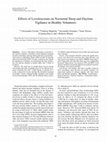
Epilepsia, 2006
Individuals with epilepsy commonly report daytime sleepiness, attributed to sleep disruption (fre... more Individuals with epilepsy commonly report daytime sleepiness, attributed to sleep disruption (frequent arousals, awakenings, and stage shifts) induced by ictal and interictal activity or antiepileptic drugs (AEDs) or both. To study the effect of levetiracetam (LEV) on sleep, at full doses but without the interference of epilepsy, we investigated the sleep architecture and daytime vigilance in healthy adults after 3 weeks of treatment. Methods: The study was of a double-blind crossover design with random allocation of multiple doses of two different treatments (randomly first LEV ≤2,000 mg/day or placebo for 3 weeks, washout for 4 weeks, and then the alternative treatment for another 3 weeks). Fourteen healthy volunteers were studied with polysomnography (PSG) and the Multiple Sleep Latency Test (MSLT). Epworth Sleepiness Scale (ESS) and sleep log also were evaluated. Results: After treatment with LEV, statistically significant increases were observed in total sleep time, sleep efficiency, and time spent in non-rapid eye movement (NREM) sleep stages 2 and 4. Stage shifts and wake after sleep onset were significantly decreased. Sleep latency was normal at PSG and MSLT in all subjects and did not statistically differ between placebo and LEV. No changes were found in the ESS. Conclusions: Our findings show that in healthy volunteers, LEV consolidates sleep and does not modify vigilance, two appreciated qualities in epilepsy patients with sleep disturbance and daytime sleepiness.
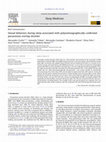
Sleep Medicine, 2011
Parasomnia overlap disorder (POD) refers to a sleep disorder characterized by the association of ... more Parasomnia overlap disorder (POD) refers to a sleep disorder characterized by the association of REM sleep behavior disorder (RBD) with NREM sleep parasomnia in the same patient. Sexual behaviors during sleep (SBS) can include most wakeful sexual activities and are classified in the ICSD-2 as a variant of confusional arousals and sleepwalking, both NREM parasomnias. A case of SBS associated with sleepwalking and possible RBD has been previously described, but it was not confirmed by polysomnography (PSG). We report two patients with SBS associated with POD documented by PSG. In one patient (60-year-old female) SBS was video-polysomnographically demonstrated: a few minute episode of masturbation occurring during slow-wave sleep (SWS) and preceded by hypersynchronous delta pattern. During the episode, the EEG pattern showed the persistence of delta rhythms with increasing alpha activity. When awoken by technicians, the patient was not aware of her sexual behavior and did not report any dream. The other patient, a 41-year-old male with a history of sleepwalking and RBD, was legally charged with repeatedly sexually fondling a young girl during the night. The POD was documented by PSG. The parasomnia defense, including sleepsex, was accepted by the Court and the patient was acquitted. This is an unprecedented report of SBS in patients with PSG-confirmed POD and of SBS documented during video-PSG.
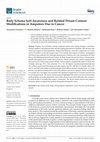
Brain Sciences
Purpose: the evaluation of body image perception, pain coping strategies, and dream content, toge... more Purpose: the evaluation of body image perception, pain coping strategies, and dream content, together with phantom limb and telescoping phenomena in patients with sarcoma who underwent surgery for limb amputation. Material and Methods: consecutive outpatients were evaluated at T0 (within 3 weeks after surgery) and T1 (4–6 months after surgery) as follows: demographic and clinical data collection; the Groningen Questionnaire Problems after Arm Amputation; the West Haven-Yale Multidimensional Pain Inventory; the Body Image Concern Inventory, a clinical trial to identify telescoping; and a weekly diary of dreams. Dream contents were coded according to the Hall and Van de Castle coding system. Results: Twenty patients completed the study (15 males and 5 females, mean age: 53.9 ± 24.6, education: 7.8 ± 3.4). All subjects experienced phantom limb and 35% of them experienced telescoping soon after surgery, and 25% still after 4–6 months. Both at T0 and T1, that half of the subjects reporte...
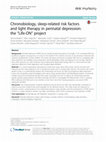
BMC Psychiatry, 2016
Background: Perinatal depression (PND) has an overall estimated prevalence of roughly 12 %. Untre... more Background: Perinatal depression (PND) has an overall estimated prevalence of roughly 12 %. Untreated PND has significant negative consequences not only on the health of the mothers, but also on the physical, emotional and cognitive development of their children. No certain risk factors are known to predict PND and no completely safe drug treatments are available during pregnancy and breastfeeding. Sleep and depression are strongly related to each other because of a solid reciprocal causal relationship. Bright light therapy (BLT) is a well-tested and safe treatment, effective in both depression and circadian/sleep disorders. Methods: In a 3-year longitudinal, observational, multicentre study, about 500 women will be recruited and followed-up from early pregnancy (10-15 gestational week) until 12 months after delivery. The primary aim of the present study is to systematically explore and characterize risk factors for PND by prospective sleep assessment (using wrist actigraphy, polysomnography and various sleep questionnaires) and bloodbased analysis of potential markers during the perinatal period (Life-ON study). Secondary aims are to explore the relationship between specific genetic polymorphisms and PND (substudy Life-ON1), to investigate the effectiveness of BLT in treating PND (substudy Life-ON2) and to test whether a short term trial of BLT during pregnancy can prevent PND (substudy Life-ON3). Discussion: The characterization of specific predictive and risk factors for PND may substantially contribute to improve preventive medical and social strategies for the affected women. The study results are expected to promote a better understanding of the relationship between sleep disorders and the development of PND and to confirm, in a large sample of women, the safety and efficacy of BLT both in prevention and treatment of PND.
Brain and Cognition, 2010
Background: This study analyzed the presence of awareness of movement disorders (dyskinesias and ... more Background: This study analyzed the presence of awareness of movement disorders (dyskinesias and hypokinesias) in 25 patients with Parkinson's disease (PD) and motor fluctuations (dyskinesias, wearing off, on-off fluctuations). Of the few studies that have dealt with this topic, none have analyzed the differences in the awareness of motor deficits by comparing the on and off states using motor scales and an extensive battery of tests to assess cognitive and behavioral functioning. Methods: PD patients were compared on three different scales that we have devised to measure awareness of movement disorders: Global Awareness of Movement (GAM) Disorders, dyskinesia/hypo-bradykinesia rating scales.
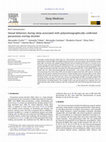
Sleep Medicine, 2011
Sexual behaviors during sleep Rapid eye movement sleep behavior disorder Non-rapid eye movement s... more Sexual behaviors during sleep Rapid eye movement sleep behavior disorder Non-rapid eye movement sleep parasomnia Parasomnia overlap disorder Polysomnography Forensic sleep medicine a b s t r a c t Parasomnia overlap disorder (POD) refers to a sleep disorder characterized by the association of REM sleep behavior disorder (RBD) with NREM sleep parasomnia in the same patient. Sexual behaviors during sleep (SBS) can include most wakeful sexual activities and are classified in the ICSD-2 as a variant of confusional arousals and sleepwalking, both NREM parasomnias. A case of SBS associated with sleepwalking and possible RBD has been previously described, but it was not confirmed by polysomnography (PSG). We report two patients with SBS associated with POD documented by PSG. In one patient (60-year-old female) SBS was video-polysomnographically demonstrated: a few minute episode of masturbation occurring during slow-wave sleep (SWS) and preceded by hypersynchronous delta pattern. During the episode, the EEG pattern showed the persistence of delta rhythms with increasing alpha activity. When awoken by technicians, the patient was not aware of her sexual behavior and did not report any dream. The other patient, a 41-year-old male with a history of sleepwalking and RBD, was legally charged with repeatedly sexually fondling a young girl during the night. The POD was documented by PSG. The parasomnia defense, including sleepsex, was accepted by the Court and the patient was acquitted. This is an unprecedented report of SBS in patients with PSG-confirmed POD and of SBS documented during video-PSG.
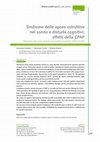
Obstructive Sleep Apnea Syndrome (OSAS) is a sleep disorder characterised by repetitive episodes ... more Obstructive Sleep Apnea Syndrome (OSAS) is a sleep disorder characterised by repetitive episodes of upper airway obstruction (apnea) or reduced airflow (hypopnoea) despite persistent respiratory effort. Apnea is defined as the cessation of breathing for at least 10 seconds during sleep, while hypopnoea is defined as at least 30% reduction in airflow for 10 seconds associated with oxygen desaturation and sleep fragmentation. The presence in the general population is about 4%. The principal symptoms are: excessive daytime sleepiness (EDS), snoring, dry throat, morning headache, night sweats, gastro-esophageal reflux, and increased blood pressure. Long term complications can be: increased cardio-cerebrovascular risk and cognitive impairment such as deficiency in attention, vigilance, visual abilities, thought, speech, perception and short term memory. Continuous Positive Airway Pressure (CPAP) is currently the best non-invasive therapy for OSAS. CPAP guarantees the opening of upper airways using pulmonary reflexive mechanisms increasing lung volume during exhalation and resistance reduction, decreasing electromyografical muscular activity around airways. The causes of cognitive impairments and their possible reversibility after CPAP treatment have been analysed in numerous studies. The findings, albeit controversial, show that memory, attention and executive functions are the most compromised cognitive functions. The necessity of increasing the patient compliance with ventilotherapy is evident, in order to prevent cognitive deterioration and, when possible, rehabilitate the compromised functions, a difficult task for executive functions. Sindrome delle apnee ostruttive nel sonno e disturbi cognitivi: effetti della CPAP Obstructive sleep apnea syndrome and cognitive impairment: effects of CPAP Disease Disclosure Gli Autori dichiarano di non avere conflitti di interesse di natura finanziaria in merito ai temi trattati nel presente articolo Narrative review Reviews in Health Care 2011; 2(4) © SEEd Tutti i diritti riservati Sindrome delle apnee ostruttive nel sonno e disturbi cognitivi: effetti della CPAP Introduzione La medicina del sonno è un campo di interesse scientifico e di ricerca, in grande crescita negli ultimi anni. Il perfezionamento di metodiche non disponibili fino a pochi anni fa e i progressi in campo tecnico hanno reso possibile la diagnosi e la cura dei disturbi del sonno e delle patologie ad esso correlate, conferendo a questa branca della medicina dignità nosografica effettiva. La gestione del paziente affetto dalla sindrome delle apnee ostruttive del sonno, spesso associata ad altre patologie, necessita di un approccio multidisciplinare. Dal punto di vista terapeutico, gli sforzi della comunità scientifica sono stati notevoli, in particolare per quanto riguarda gli aspetti chirurgici e lo sviluppo di nuovi apparecchi di tipo odontostomatologico, quali riposizionatori mandibolari o linguali, attualmente usati nei pazienti affetti dalla sindrome delle apnee ostruttive durante il sonno (Obstructive Sleep Apnea Syndrome, OSAS) di grado lieve/moderato o intolleranti al trattamento a ventilazione a pressione positiva continua. Il trattamento di elezione per l'OSAS rimane infatti la ventilazione meccanica a pressione positiva delle vie aeree (Continuous Positive Airway Pressure, CPAP) quale trattamento protesico non invasivo per questa sindrome dalle molteplici implicazioni [1]. L'uso regolare della CPAP riduce la morbilità e mortalità cardiovascolare e, normalizzando la macro e micro-struttura del sonno, porta alla scomparsa dell'ipersonnia diurna [2]. La sua efficacia nella riduzione del deficit cognitivo spesso secondario all'OSAS è ancora oggetto di studio.
Reviews in Health Care, Sep 5, 2011
Epilepsia, 2006
Purpose: Individuals with epilepsy commonly report daytime sleepiness, attributed to sleep disrup... more Purpose: Individuals with epilepsy commonly report daytime sleepiness, attributed to sleep disruption (frequent arousals, awakenings, and stage shifts) induced by ictal and interictal activity or antiepileptic drugs (AEDs) or both. To study the effect of levetiracetam (LEV) on sleep, at full doses but without the interference of epilepsy, we investigated the sleep architecture and daytime vigilance in healthy adults after 3 weeks of treatment.





Uploads
Papers by Alessandra Giordano